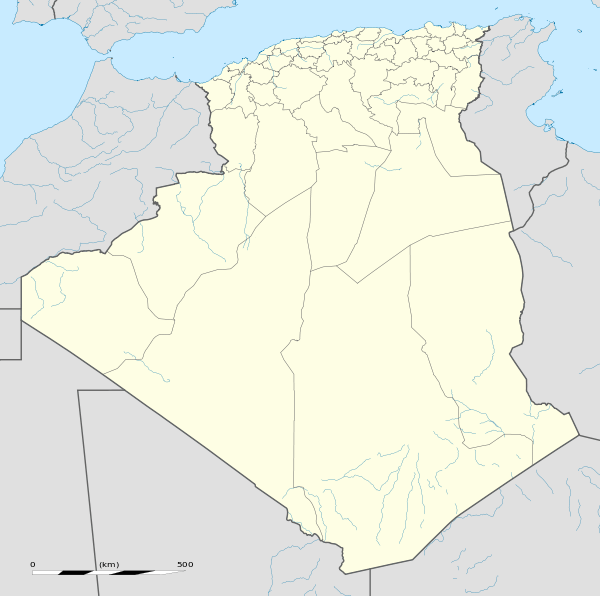Royal Mausoleum of Mauretania
| Royal Mausoleum of Mauretania | |
|---|---|
|
Mausoleum of Mauretania. | |
| Location | Tipaza Province, Algeria |
| Coordinates | 36°34′29″N 2°33′12″E / 36.57472°N 2.55333°ECoordinates: 36°34′29″N 2°33′12″E / 36.57472°N 2.55333°E |
| Built | 3 BC |
 Location of Royal Mausoleum of Mauretania in Algeria | |
The Royal Mausoleum of Mauretania is a funerary monument located on the road between Cherchell and Algiers, in Algeria. The Mausoleum is the tomb where the Berber King Juba II and Queen Cleopatra Selene II, sovereigns of Mauretania, are buried.
History
The sepulchre is sometimes known as the Mausoleum of Juba and Cleopatra Selene. In French, it is called the Tombeau de la Chrétienne ("the tomb of the Christian woman") because there is a cross-like shape of the division lines on the false door. In Arabic, the mausoleum is called the Kubr-er-Rumia or Kbor er Roumia, which means the tomb of the Roman woman. When the Umayyad Caliphate first spread its influence in the Maghreb, its forces used to call people or places that they conquered Rûm, "Roman", after the Eastern Roman Empire.
Royal Family of Mauretania
The mausoleum was built in 3 BC by the last King of Numidia, and later King of Mauretania, Juba II, and his wife Cleopatra Selene II. Cleopatra Selene II was an Egyptian Greek Ptolemaic princess, the daughter of the Queen Cleopatra VII of Egypt and Roman Triumvir Mark Antony. Through her marriage to Juba II, she became the last Queen of Numidia and later Queen of Mauretania.
The mausoleum is probably the Royal Tomb that the 1st-century Roman geographer Pomponius Mela (1.31) described as the monumentum commune regiae gentis ("the communal mausoleum of the royal family"). If the geographer’s description of the mausoleum is correct, then the building was not intended just for Juba and Cleopatra, but envisaged as a dynastic funeral monument for their royal descendants.
The Mauretanian sepulchre looks similar to the Mausoleum of Augustus erected by the first Roman Emperor, Augustus, in Rome. Augustus began constructing his mausoleum between 29 BC-27 BC, some time before Juba II left Rome to return to Numidia.
Construction
The Royal Mausoleum of Mauretania is a common type of ancient mausoleums found in Numidia. The architectural type of the monument originates from the various Ancient Greek mausoleums from Anatolia and Egypt. It is built on a hill some 250 metres (756 feet) above sea level. The monument is entirely built from stone, while its main structure is in a circular form with a square base topped by a cone or a pyramid. The square base measures 60 to 60.9 metres square or 200 to 209 foot. The height of the monument was originally about 40 metres or 130’ in height. Due to damage that the mausoleum has suffered from natural elements and vandalism, the monument now measures 30-32.4 metres in height. The base of the monument was decorated with 60 Ionic columns whose capitals were removed, possibly stolen. Inside, the centre of the mausoleum has two vaulted chambers, separated by a short passage connected by a gallery outside by stone doors which can be moved up and down by levers. The passage leading to the chambers is about 500’. One chamber measures 142 feet long by 11 feet broad and is 11 feet high, while the other is smaller.
Under the Ottomans and French
_-_Google_Art_Project.jpg)
In 1555, the Pasha of Algiers, Salah Rais, gave orders to pull down the mausoleum. After large black wasps swarmed out and stung some of the workers to death, the effort was abandoned. At the end of the 18th century, Baba Mahommed tried in vain to destroy the monument with artillery. Later, when the French occupied Algeria the monument was used by the French Navy for target practice.
Recognition and conservation of the Mausoleum
The Royal Mausoleum of Mauretania is a part of a unique archeological site along the road from Cherchell to Tipaza. On this archeological site, there are various monuments and infrastructure that have survived from the Phoenician (see also Carthage National Museum), Roman, Early Christianity and Byzantine periods. This group of ruins that are located along the Mediterranean Sea were recognized and inscribed on the UNESCO World Heritage Site in 1982.
Although these archeological remains, including the Royal Mausoleum of Mauretania, are protected, the ruins located between Cherchell and Tipaza face constant threats from continual urban construction and expansion, open sewage drainage run offs, poor maintenance, and constant vandalism. Due to these ongoing problems, these archaeological remains face an uncertain future.
The local authorities have failed and had problems implementing a 1992 ‘Permanent Safeguarding and Presentation Plan’ an effective management program in preserving these ruins. In 2001, the World Heritage Site provided emergency assistance for this archaeological site. In 2002, experts from UNESCO went to visit the site and to report on the condition of the ruins; the archeological site has been placed on the List of World Heritage Sites in Danger.
See also
Sources
- Duane R. Roller, The World of Juba II and Kleopatra Selene: Royal Scholarship on Rome's African Frontier. New York and London: Routledge, 2003
- http://www.lunalucifera.com/Mauretania/index.html
- http://whc.unesco.org/documents/publi_news_35_en.pdf
- http://www.algeria.com/blog/algeria-archeological-finds-reveal-a-varied-past
External links
- Duane R. Roller, The World of Juba II and Kleopatra Selene: Royal Scholarship on Rome's African Frontier. New York and London: Routledge, 2003
- Page at UNESCO website